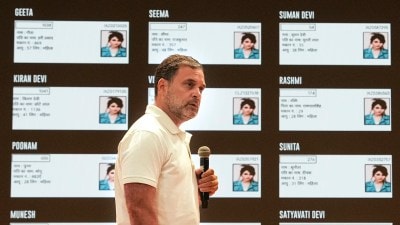Cancun: a mystery story
There have been several post-mortems of what happened in Cancun. Flowing from that, there have also been some ante-mortems of the Doha Devel...

There have been several post-mortems of what happened in Cancun. Flowing from that, there have also been some ante-mortems of the Doha Development Agenda (DDA). There is near consensus that unless things change dramatically, the January 2005 deadline for DDA is dead. Interpreted thus, Cancun was not a comma. It was a full stop. Things may indeed change dramatically in Geneva or elsewhere. But what do we mean by things changing dramatically?
There are five contentious issues — TRIPs and public health, agriculture, Singapore issues, non-agricultural market access (NAMA) and special and differential (S&D) treatment for developing countries. Of these, the TRIPs problem was “solved” before Cancun. S&D is
critically linked to agriculture. NAMA is not that serious a problem. Everything therefore boils down to Singapore and agriculture. Given the polarisation, people are understandably sceptical about positions on these changing dramatically. If that was going to happen, it should have happened on 13th September.
On 13th September, a Draft Ministerial Text surfaced in Cancun and effectively killed the Cancun Ministerial, although negotiations went on also on 14th September. Thanks to negotiations on 14th September, there was some convergence on Singapore and on agriculture. If there is an attempt to revive DDA, will it be based on this convergence or something else? Where does the 13th September draft stand now? No doubt the commerce ministry knows. But what intrigues me is that this draft has completely disappeared from WTO’s website. Instead, the WTO website has its precursor, the 24th August Draft Ministerial Text. Nor will you find this 13th September draft archived on any media website, including Indian ones. There were reactions to the 13th September draft but primarily because of the time difference between India and Mexico, no Indian media reported on the 13th September draft.
Let me therefore quote a little from the 13th September draft to illustrate the kind of damage it did. Consider first, the matter of cotton subsidies, of concern to Burkina Faso, Benin, Chad and Mali. On 24th August, the proposal made by these four African countries was noted. The 13th September draft stated: “The Director General is instructed to consult with the relevant international organizations including the Bretton Woods Institutions, the Food and Agriculture Organization and the International Trade Centre to effectively direct existing programmes and resources towards diversification of the economies where cotton accounts for the major share of their GDP. Members pledge to refrain from utilizing their discretion within Annex A, paragraph 1 to avoid making reductions in domestic support for cotton.” Annex A, paragraph 1 is a reference to reducing domestic support in agriculture. In plain English, what does this quote tell you? Developed countries, like the USA, won’t have concrete commitments to reduce domestic support in cotton. If you have a problem with that, diversify and move away from cotton. So wouldn’t you have revolted?
On all four Singapore issues (trade facilitation, transparency in government procurement, competition policy, investment), 24th August gave us two options. “We decide to commence negotiations” or the situation “does not provide a basis for the commencement of negotiations in this area”. 13th September changed that. On investment, “we agree modalities that will allow negotiations on a multilateral investment framework to start shall be adopted by the General Council no later than…” The date was unspecified, but a footnote stated,”The date will coincide with the date for agreeing on modalities on agriculture and NAMA.” So there would be a link between investment, agriculture and NAMA. Because the US didn’t want a competition policy, the language used there was slightly different.”We decide that further clarification of the issues be undertaken in the Working Group, including consideration of possible modalities for negotiations.” No ambiguity on government procurement and trade facilitation. “We decide to commence negotiations.” Doha did say something about negotiations on Singapore issues “on the basis of a decision to be taken, by explicit consensus, at (Cancun) on modalities of negotiations.” But junk that.
The Draft Ministerial Declarations don’t make sense without bringing in some annexes. As I have said earlier, Annex A is on agriculture. Let me again give a few quotes to illustrate how life changed between 24th August and 13th September. The 24th August said the final bound total AMS would be changed, 13th September added, “Product-specific AMS shall be capped at their respective average levels during the period.” Meaning that non-product specific AMS was fine and shouldn’t be capped? 24th August said,”Green Box criteria remain under negotiation.” 13th September changed this to,”Green Box criteria shall be reviewed with a view to ensuring that Green Box measures have no, or at most minimal, trade-distorting effects or effects on production.” The change in nuance is inescapable. Green Box measures don’t distort trade and should be accepted. On market access, 24th August offered, “For the tariff lines that exceed a maximum of…developed-country participants shall either reduce them to that maximum, or ensure effective additional market access in these or other areas through a request-offer process that could include TRQs (tariff rate quotas).”
Fine. But 13th September added the rider, “Within this category, participants shall have additional flexibility under conditions to be determined for a very limited number of products to be designated on the basis of non-trade concerns that would only be subject to the provisions of paragraph 2.1 (general tariff reduction) above.” Who has this flexibility? Make no mistake. Developed countries do. Because, “The applicability and/or extent of the provisions of paragraph 2.2 above to developing countries remain under negotiation, taking into account their developmental needs.” There is a Peace Clause. To state it simply, under this, you don’t take action against subsidised agro exports and this clause was supposed to end in December 2003. 13th September slipped in, “The Peace Clause will be extended by….months.”
There is more in similar vein. The message is simple. As a Draft Ministerial Declaration that seeks to bring about a compromise, the 24th August version was better than the 13th September one. Hence my question, what happened to the 13th September draft? Has the devil in the detail been buried and are we back to 24th August? Or will there be a resurrection? I wish I knew.



- 01
- 02
- 03
- 04
- 05




























